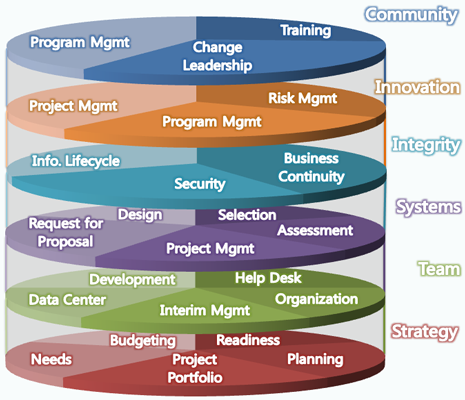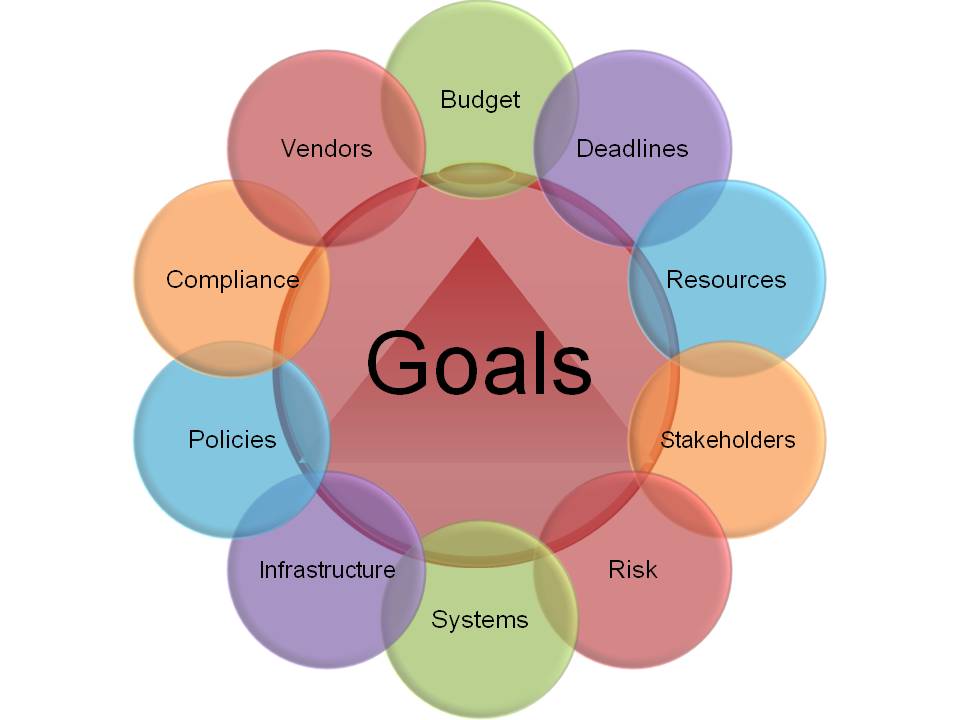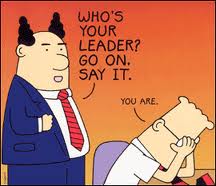Our Services
- Service Lines Overview
- Program Management
- Project Management
- Project Portfolio Management
- Change Leadership
- Training
- Risk Management
- Strategy and Planning
- Solution Selection, Design and RFP
- Information Security and Secure Infrastructure
- Fractional and Interim Leadership
- Organizational Development
- Business Continuity Planning
IT initiatives grow evermore complex, and success requires good decision making and tight coordination of activities. That’s just what we do; our experienced team provides you the right blend of services to manage process and quality – and to deliver successful solutions.
We view complex initiatives as spanning six, distinct domains of expertise - these are shown below in our service model as a hierarchy of six discs; each disc depending on work done in the discs below it. We provide you requisite services in every one of these domains of expertise.

Finally, we can help you from start to finish, and anywhere in between – we’re committed to making smart decisions and achieving the expected results. You’ll find us personal and committed – your success really is a very big deal for us.

Program Management - Our Core Competency
The delivery of major initiatives through the coordination of many individual projects.
Successful program management requires a blend of disciplines, such as planning, resource management, change leadership, technical competencies, technical architecture, system development methodologies, risk management, and team facilitation.
Here’s a sample of our successfully completed programs:
- Student Information Systems (SIS) – we’ve run, from selection through deployment, SIS implementations for several, sizeable K12 school districts. These systems have a tremendous scope of functionality to configure, and changes affect a large number of stakeholders.
- Front Office Refresh – We’ve helped clients, across industries, replace and upgrade their “front office” systems. This involves changes in PC equipment and software, enterprise applications such as document management systems, and support services such as remote access solutions. These programs are complex, require extensive system validation and present challenging migration issues.
- Enterprise Resource Planning (ERP) Systems – We’ve led programs for several clients to replace their ERP systems. For example, for a $311M publicly traded apparel company, we led the simultaneous replacement of their ERP and warehouse systems. Delivery was on-time and in-budget, and the transition was managed without impacting quarterly metrics.
- Company Acquisition – We led the technical integration and migration for a client to complete the acquisition of one of its competitors.

Project Management
A focused endeavor that produces a solution; it is defined by its duration, budget, milestones, tasks, and resources.
Your project depends on your selecting the right project manager; our project managers are smart, capable and experienced.
We have an extensive track record of successful projects (which is the foundation for our success with program management). Some examples:
- Authored a request for proposal (RFP), and managed the RFP process, for implementation of a metropolitan area network across 17 sites.
- Migrated an on-line store (selling books and supplies) to a new platform, and introduced tight integration with the company’s ERP system.
- Designed, and then led development and implementation of, a secure remote access solution for a 1,000+ end-user organization.
- Led a business continuity readiness review and remediation project for a mid-sized organization, and subsequently coordinated a test of the resulting business continuity plan.
- Led the design and development efforts for custom integration between a web-based service (used by thousands daily) and an ERP system, in achieve real-time capture of financial transactions.

Project Portfolio Management (PPM)
The art of tracking, prioritizing, and coaching all of a department’s projects.
Assembling a project portfolio provides a particularly good diagnostic when there are concerns regarding the timeliness or quality of a department’s project delivery. With ongoing management of the project portfolio, our clients see a myriad of long-term benefits:
- Accurate and timely status - Dashboards provide summaries of a department’s projects to executives, project sponsors, department management, and project managers. Various dashboard templates can be tuned for the needs of different stakeholders.
- Key metrics – These allow you to know the actual count, nature, and resource requirements of all the department’s projects.
- Prioritization and filtering – By reviewing the dashboards against available resources, your team can set meaningful priorities on the different projects. Adding a simple project initiation process allows you to decide which ideas become active projects (and when).
- Risk mitigation – Metrics, properly presented at both the project and portfolio levels, enable you to identify projects at risk – and to provide timely triage to avoid bad outcomes.
- Improve staff capability – Gathering status and addressing project risk allow our team to teach and coach your team.

Change Leadership
Activities that enable and sustain comprehensive changes required of leadership and stakeholders.
Fear of, and resistance to, change is a natural reaction to the uncertainty that comes with innovation; without a compelling case for change and a steady effort to build momentum, major initiatives often become paralyzed (and often at vulnerable moments.) That’s why change leadership is a critical success factor when delivering large initiatives; and why we include a change leadership project whenever we provide program management.
We work with you to form a change leadership team and engage in five concurrent tracks of activity:
- Motivating Change - This involves working with stakeholders to create readiness for change and overcome resistance.
- Creating a Vision - We communicate how the initiative advances the organization’s mission, highlighting valued outcomes and stressing visible midpoint goals.
- Developing Political Support - By identifying and influencing key stakeholders, the initiative gains power to drive change. Often, this power will be needed when the initiative is challenged.
- Managing the Transition - This involves carrying stakeholders through the conversion. Conversion activities are carefully scripted; stakeholder commitments obtained; training provided; and support and management structures setup.
- Sustaining Momentum - Once through the conversion, stakeholders must be provided ongoing resources and support (else they will tend to revert to established procedure). New behaviors must be reinforced and new competencies developed.

Training
To make proficient by instruction, in order to achieve a specific mission or objective.
With effective training, your team gains the skills and confidence to move forward with new systems. Often, training is a key factor for team members to embrace change.
We have dynamic and caring trainers, with substantial experience delivering successful results for large law firms. They will work with you to:
- Develop your curricula and support documentation.
- Train your end-user community.
- Provide follow-up floor support and refresher training.
- Augment and train your Help Desk team.
- Assist with the planning and execution of system migrations.
We generally can scope a training solution to your needs and budget. For example, we can perform all training, or we can help you identify team members to be internal trainers and “train the trainer”; and we can train globally by traveling to your sites or by leveraging webinars and remote conferencing tools.

Risk Management
Minimizing both the likelihood and impact of bad things happening to an initiative.
Large initiatives tend to fail, generally due to program management lapses and serious issues emerging at the wrong times. We address the latter by focusing on the early identification of potential issues (risks), so that we can proactively monitor and mitigate them. In effect, we achieve success by avoiding surprises.
To achieve this, we form and chair a Risk Management Committee to:
- Identify the risks that can derail the initiative, and assess their likelihood and impact.
- Assign ownership for monitoring and addressing these risks.
- Work with risk owners to develop and execute action plans that reduce risks and consequences.
- Prioritize risks for attention, and monitor accordingly.
- Proactively and reactively manage risks and consequences.
Strategy and Planning
Asking good questions, determining objectives, and planning for achievement.
We found our strategy work on achieving two key outcomes. First, we apply analytical rigor so you can decide exactly what to accomplish and clearly explain why to stakeholders. Second, we produce very detailed plans that incorporate everyone involved.

We offer broad expertise with technology strategy, including for:
- Enterprise-wide initiatives, such as ERP and student information systems. Strategic planning provides a foundation for program management.
- Consolidation of systems, driven by acquisition activity or a desire to reduce costs.
- Project prioritization within the project portfolio, to maximize benefits from limited development resources.

Solution Design, Selection and RFP
The structured decision making processes, prior to implementation, which maximize the return on a technology investment.
Solution design and selection involves a series of complex decisions – and you’ll be living with the consequences for years. We believe good results come from making good decisions at each step, and that bad results often come from trying to skip steps.
That’s why we follow a rigorous, structured approach to this. Once you’ve made the strategic decision to proceed, we open our library of methodologies to you and collaborate on a selection process suitable to the solution and your needs. The following are common steps in the process:
- Requirements - We assess your needs and itemize what needs to be delivered. We also can help you set objectives for service levels and define system acceptance criteria.
- Architecture - After assessing the state of the art, we divide the solution into a meaningful hierarchy (architecture) of components. Next, decisions are made regarding what to source from vendors and what to develop in-house.
- Vendor selection & contracting - We are skilled in developing requests for information (RFI) and proposals (RFP) that yield a sound selection and excellent pricing.
- Integration and component design - You may need custom development. Our design services provide high-level and detailed specifications for development teams, and we can oversee the development process.
- Project plan - we find it a good project management practice to prepare a project plan while the architecture is defined, and then continually refine it.

Information Security and Secure Infrastructure
Information Security protects information, an enterprise asset, by ensuring its appropriate confidentiality, availability and integrity. Secure infrastructure provides services while meeting information protection objectives, and can be a foundation for competitive innovation.
We understand security. Prior to founding Ascendant Services, our principal was nominated for Partner in an information security practice at Deloitte & Touche; additionally, several members of our team hold CISSP certifications. We often fill the CSO role for our small to mid-sized clients.
We believe information protection is an essential objective for IT management – and we build it into everything we design, procure, and configure.
As an excellent way to start working with us, consider an information protection assessment, which are short engagements with immediately usable results. Our methodology takes a management perspective to security, and produces results that are readily understandable and actionable by the executive team.
We provide highly qualified project managers to lead selection and implementation of secure, enterprise infrastructure. Our project work includes:
- Remote access solutions that support thousands of team members
- Secure portals that support tens of thousands of stakeholders
- Antivirus/malware suites for thousands of personal computers
- Network security solutions to protect multi-campus organizations
- ISO27002 compliant information protection programs

Fractional and Interim Leadership
Managing a department or team during transitions, such as: staff turnover, reorganizations, turnarounds, acquisitions, expansions, and other periods of extraordinary change.
Inevitably, circumstances arise and a client faces a leadership gap of weeks to months. These gaps are generally stressful for everyone, and can excessively consume other executive’s time.
We believe that coasting without leadership often yields declining productivity and quality; and minimally “filling the gap” contributes little towards positive momentum. Also, you miss a real opportunity for constructive change - with no incumbent in place, you can readily take a fresh look at mission, processes, staffing mix, and possible opportunities.
During such times, we recommend and provide qualified interim leadership services for our clients. These services generally involve:
- Hands-on management of operations and the project portfolio.
- Ensuring effective communication between technical staff and executive management.
- Efficiently using senior management’s time. We are organized and analytic - and so we maximize the effectiveness of, and minimize the intrusion on, executive time.
- Setting up the incoming leader for success, by making improvements (including “incumbent unfriendly” ones) and by preparing a “roadmap” of the environment (i.e., documenting active projects, organizational structure, key processes, etc.).

Organizational Development
You want to make your organization more effective, and see the need to:
- Teach your employees/team the strategic principles and applications that have proven to work in consumer-centric organizations.
- Align your employees/team with a shared mindset and "common" language across multiple business functions.
We can create a customized in-depth seminar for product development, marketing, and/or sales (or all functions together). A few examples include:
- Effectively managing the creative process from idea to strategy to execution.
- Consumer-centric product development.
- Optimizing product, marketing, and sales collaboration.
- Creative research methods to glean consumer insights and build a strong brand story.
- How to be a more effective presenter.
- In-house training customized to your organization needs.

Business Continuity Planning (BCP)
Defining processes to follow when bad things happen to your technology infrastructure (and making sure they work).
Many organizations are finding themselves evermore dependent on their information technology infrastructure – and increasingly concerned about protecting their operations when that infrastructure fails or is damaged.
Successful business continuity planning requires a leader who can bring together expertise in business, technology, change leadership, and project management.
We’re led business continuity projects for several of our clients, and we are ready and capable to lead yours. We’ve found a five step process to delivering a working plan:
- Decide what your organization wants (and can afford) to happen when things go wrong.
- Determine the gap between what you want and what you have.
- Lead the process of remediating the gaps.
- Prepare (or coordinate preparation of) a response plan.
- Train your team on how to use the plan, and then test it.

Assessment and Needs Analysis
ipso lorem
Ipso lorem

Information Lifecycle Management
ipso lorem
Ipso lorem
